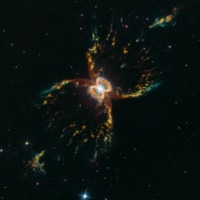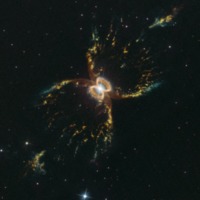Southern Crab Nebula
Dublin Core
Title
Subject
Description
ABOUT THIS IMAGE
In celebration of the 29th anniversary of the launch of NASA's Hubble Space Telescope, astronomers captured this festive, colorful look at the tentacled Southern Crab Nebula.
The nebula, officially known as Hen 2-104, is located several thousand light-years from Earth in the southern hemisphere constellation of Centaurus. It appears to have two nested hourglass-shaped structures that were sculpted by a whirling pair of stars in a binary system. The duo consists of an aging red giant star and a burned-out star, a white dwarf. The red giant is shedding its outer layers. Some of this ejected material is attracted by the gravity of the companion white dwarf.
The result is that both stars are embedded in a flat disk of gas stretching between them. This belt of material constricts the outflow of gas so that it only speeds away above and below the disk. The result is an hourglass-shaped nebula.
The bubbles of gas and dust appear brightest at the edges, giving the illusion of crab leg structures. These "legs" are likely to be the places where the outflow slams into surrounding interstellar gas and dust, or possibly material which was earlier lost by the red giant star.
The outflow may only last a few thousand years, a tiny fraction of the lifetime of the system. This means that the outer structure may be just thousands of years old, but the inner hourglass must be a more recent outflow event. The red giant will ultimately collapse to become a white dwarf. After that, the surviving pair of white dwarfs will illuminate a shell of gas called a planetary nebula.
The object was first reported in the late 1960s, but was assumed to be an ordinary star. In 1989, astronomers used the European Southern Observatory's La Silla Observatory in Chile to photograph a roughly crab-shaped extended nebula, formed by symmetrical bubbles.
These early observations only showed the outer hourglass emanating from a bright central region. Hubble photographed the Southern Crab in 1999 to reveal complicated nested structures. These latest images were taken in March 2019 with a wide set of color filters on Hubble's newest, sharpest detector, Wide Field Camera 3. This image is a composite of observations taken in various colors of light that correspond to the glowing gases in the nebula. Red is sulfur, green is hydrogen, orange is nitrogen, and blue is oxygen.
ABOUT THE OBJECT
Object Name:
Southern Crab Nebula; He2-104
Object Description:
Nebula with symbiotic Mira variable and white dwarf pair
Object Position:
R. A. 14:11:52.09
Dec. -51:26:24.39
Constellation:
Centaurus
Distance:
10,700 light-years
Dimensions:
Image is 1.4 arcmin across (about 4.4 light-years).

